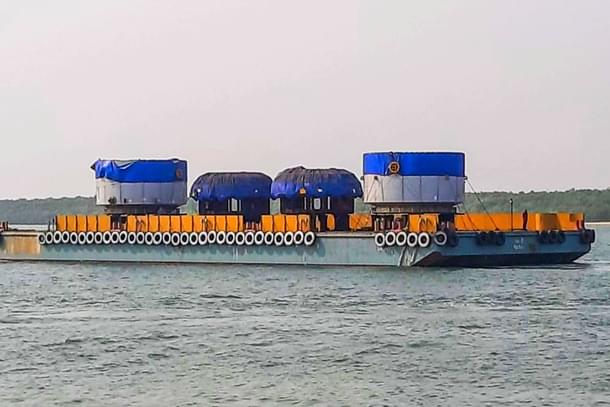Economy
Meet ‘Jalvahak’ : A Revolutionary Push For Connecting India By Inland Waterways
Amit Mishra
Dec 19, 2024, 12:03 PM | Updated Dec 20, 2024, 05:51 PM IST
Save & read from anywhere!
Bookmark stories for easy access on any device or the Swarajya app.


After years of red tape, dredging dilemmas, and policy gridlock, the government on 15 December unveiled a major policy to supercharge cargo transport through India’s inland waterways.
The scheme christened ‘Jalvahak’ incentivises long haul cargo movement via National Waterways 1 (the Ganga), National Waterways 2 (the Brahmaputra), and National Waterways 16 (the Barak).
But why is this such a big deal? Let’s step back for a moment and set the stage.
The Obvious Advantage
India is blessed with a vast riverine network, stretching across its Himalayan heartlands and southern peninsula, enriched by canals, backwaters, and creeks.
With a total navigable length of 20,236 km—comprising 17,980 km of rivers and 2,256 km of canals—this network is perfectly suited for mechanized craft, offering massive potential to reshape the nation’s logistics landscape.
The advantages of waterways over rail and road are staggering.
Consider this: 1 HP can move 150 kg on road, 500 kg on rail, and an incredible 4,000 kg on water. In terms of fuel efficiency, 1 litre of fuel carries 24 tonnes of freight 1 km by road, 85 tonnes by rail, and 105 tonnes by water. What’s more, inland water transport slashes carbon dioxide emissions by nearly 50 per cent compared to trucks.
Delayed Start
For decades, India’s vast river network lay dormant, a forgotten asset in the nation’s transportation matrix. It wasn’t until the early 2000s that the government started making serious strides toward developing inland waterways.
At that stage, water transport accounted for a mere 0.15 per cent of the country’s cargo movement, starkly contrasting with countries like Germany at 20 per cent and neighboring Bangladesh exceeding 32 per cent.
In 2016, the government made a game-changing move by designating 111 inland waterways as National Waterways under the National Waterways Act. Work began immediately to make these routes operational.
The results speak for themselves: the total volume of cargo transported on national waterways soared from 18.07 million metric tonnes in 2013-14 to 132.89 million metric tonnes in 2023-24— an astounding 700 per cent growth.
Despite these gains, river transport faces significant challenges that have slowed the pace of development. The natural meandering of rivers makes the transport corridors longer compared to roads and railways, which run in a straight line.
While moving a tonne of cargo over a kilometre costs Rs 1.36 by rail, Rs 2.50 by road, and Rs 1.06 by water, the higher infrastructure costs for loading and unloading cargo, combined with the slower pace of movement, often neutralize this apparent cost advantage.
On Offer
India’s inland waterways are still underutilized, but a major policy overhaul has taken place in the last three years.
In 2021, Parliament passed a new law aimed at standardizing the rules and regulations governing inland waterways and navigation on them. Following this, the Centre unveiled a Rs 15,200 crore investment plan in October this year to ramp up cargo movement on these waterways.
Now, responding to the need for greater support, the Centre has launched the ‘Jalvahak’ cargo promotion scheme, offering direct incentives to the cargo owners to transport their goods via inland waterways for a distance of more than 300 kms.
Under the scheme, cargo owners can receive up to 35 per cent reimbursement on total operating expenses for transporting goods along NW1, NW2 , and NW 16, including the Indo-Bangladesh Protocol (IBP) route.
A collaborative effort by the Inland Waterways Authority of India (IWAI) and the Inland & Coastal Shipping Limited (ICSL), a subsidiary of the Shipping Corporation of India, the scheme also allows cargo owners to hire vessels from private companies, broadening the appeal for major shipping companies, freight forwarders, and trade associations handling bulk and containerized cargo.
The scheme, valid for three years, aims to shift 800 million ton-kilometers of cargo to waterways by 2027, offering substantial incentives to cargo owners who make the switch.
The Catch
India’s logistics cost currently stands at around 13 per cent, but with the expansion of inland waterways, there’s a real opportunity to bring that figure below 10 per cent, aligning with global standards seen in developed nations.
However, the success of the ‘Jalvahak’ scheme relies on much more than just financial incentives. It requires a massive investment in infrastructure, including the development of modern terminals, jetties, and navigational aids to ensure safe and efficient cargo movement.
Moreover, tackling challenges like seasonal fluctuations in water levels and improving last-mile connectivity to industrial and commercial hubs are crucial for the successful implementation of this ambitious project.




